Experience the Wild Heart of Scotland: Our Journey to See Handa Island Puffins
Have you ever wondered what it’s like to be in a place where nature takes centre stage? We discovered just that on our visit to Handa Island, a breathtaking wildlife sanctuary in Scotland.
Managed by the Scottish Wildlife Trust, this Nature Reserve is a site of scientific interest and a refuge for rare and migratory birds.
Join us as we share our firsthand experiences of Handa’s fresh sea air, the chorus of seabirds, and stunning landscapes that captivated us at every turn.
Let us guide you through the natural splendour of Handa Island, a jewel in Scotland’s majestic wilderness.
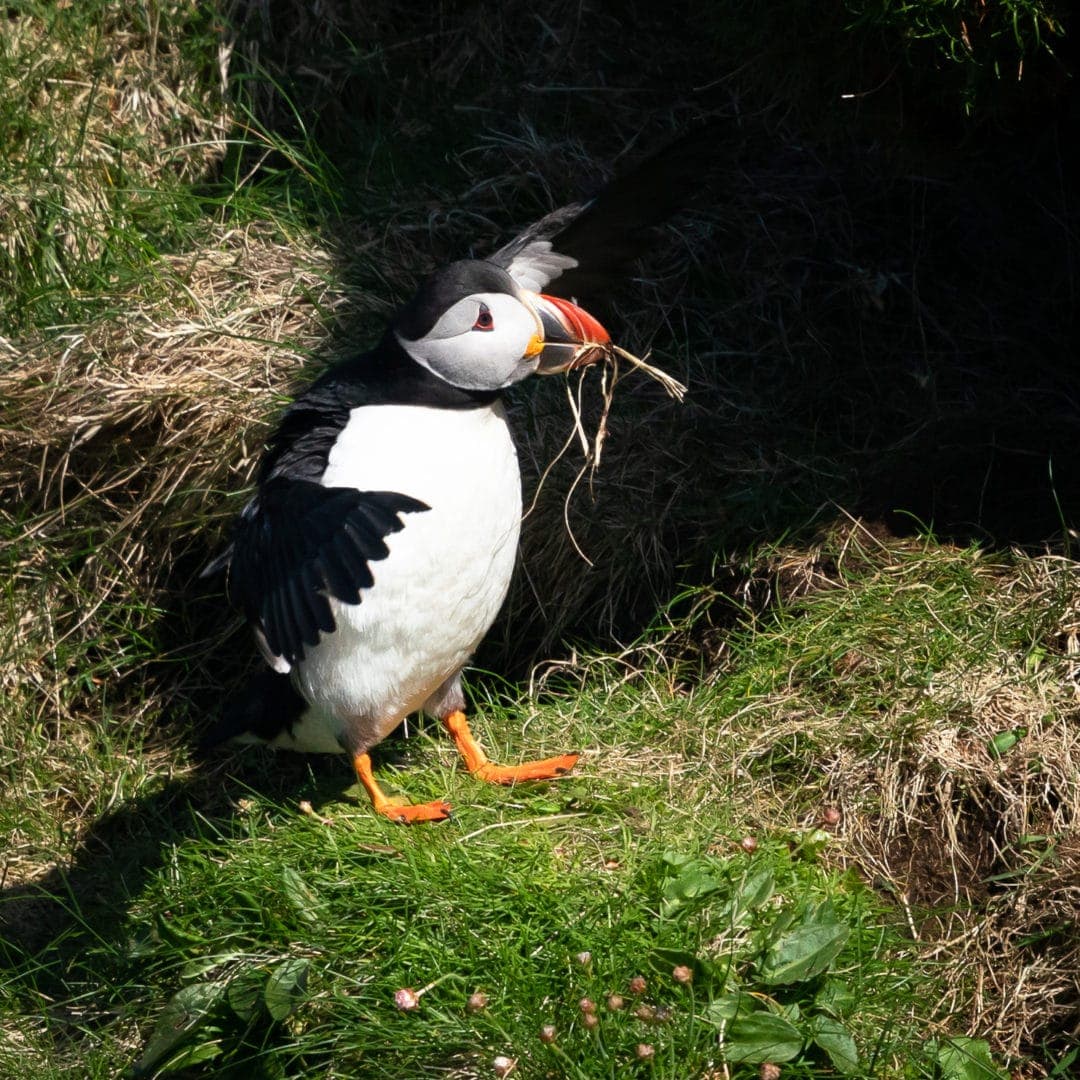
🥜 How to Visit Handa Island Puffins in a Nutshell
How to get to Handa Island: The ferry to Handa Island leaves from Tarbet Pier from April to August. It’s advisable to arrive early for the first trip to maximise your day. The best times to see puffins are May, June and July.
- The round trip costs £20 per adult (2024 price)
- The ferry has a limited capacity, so arrive early (especially on sunny days).
- No dogs are allowed on Handa Island or the ferry
- Pay by cash only
- Handa Island ferry times: Monday to Saturday, 9 am to 1.30 pm, outgoing times—depending on weather, last return ferry at 5 pm.
- Cannot pre-book a time
First Steps on the Island: Upon arrival, rangers or Wildlife Trust volunteers welcome you to the information hut. They provide valuable insights about the island, including recent sightings, trail expectations, and essential guidelines to preserve the natural beauty while enjoying the landscape and wildlife.
The Handa Experience: The island offers a 6.4 km circular path leading through moorland, along steep sandstone cliffs and close to the shore where marine animals can be spotted. Watch out for the divebombing Skuas! The path also takes you past historical ruins, offering glimpses into the island’s past.
Wildlife Wonders: Handa’s cliffs are bustling with seabirds like guillemots, razorbills, kittiwakes, puffins, and shags. The Great Stack is an ideal spot for observing puffins, offering a spectacle of seabirds vying for space on cliffs.
Marine Sightings: The island’s high cliffs provide vantage points to spot whales, dolphins, porpoises, seals, and even orcas, while otters and seals are often seen cruising the coastline.
Preparation For Your Trip: Due to unpredictable Scottish weather, it is recommended that you dress in layers and wear waterproof gear. Sturdy walking shoes are essential for walking around the island. Don’t forget to pack water and snacks, as Handa Island has no facilities, and binoculars and your camera.
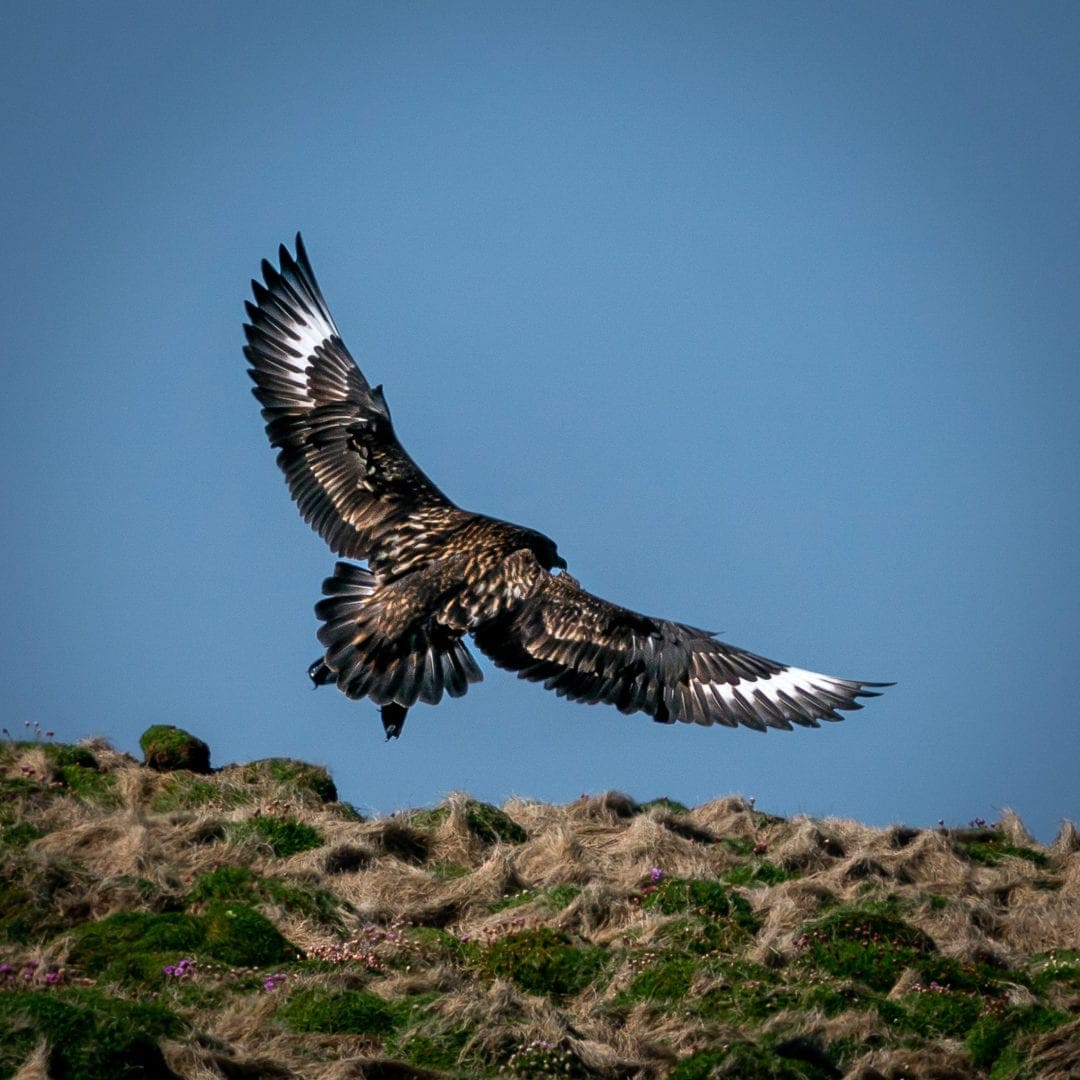
Is Handa Island Worth Visiting?
One of the most frequent questions we get asked is, “Is Handa Island worth visiting?” After spending a day immersed in its natural beauty and wildlife, here’s our take.
Why Visit Handa Island?
If you’re keen on wildlife photography, a nature enthusiast, or simply looking for a peaceful escape, Handa Island offers a rare glimpse into Scotland’s wild heart. With its bustling colonies of seabirds, including puffins, guillemots, and skuas, and the chance to spot marine animals from its dramatic cliffs, the island provides a unique adventure.
Things to Consider
Handa isn’t your typical tourist destination. There are no cafes, shops, or restrooms beyond the starting point, and its rugged terrain demands good physical health and preparation. The ferry service has limited capacity and operates only in favourable weather, so planning ahead is crucial.
Our Personal Experience
For us, the trip was absolutely worth it. The blend of excitement and tranquillity as we explored the island’s paths, with every turn offering a new view or a wildlife encounter, was unforgettable. It’s a day we talk about often, filled with vibrant images and interactions with nature that we treasure.
Handa Island is a gem worth exploring for those who appreciate the untamed and don’t mind a bit of mud on their boots.
If you’re wondering whether it’s right for you, think about what you love in an adventure—Handa might just be the perfect fit.
What are your thoughts? Does this wild part of Scotland call to you?
Keep reading for all the details on how to make the most of your visit to Handa Island.

Handa Island Map
Handa Island is in Sutherland, in the northwest of Scotland and just a 10-minute ferry ride from the mainland.
About Handa Island
Handa Island is owned by the Scourie Estate, but the Nature Reserve is managed by the Scottish Wildlife Trust. It is a Scottish Site of Specific Scientific Interest (SSSI) and also a Special Protected Area (SPA).
An SPA is a special site designated under the EU Birds Directive to protect rare, vulnerable and migratory birds.
Over 200,000 seabirds arrive at Handa Island to set up home for the summer. They immediately busy themselves with building burrows and nests or simply laying claim to a few inches on the steep cliff ledges on the island.
Mating pairs bond and the ritual of producing the next generation of seabirds begins.
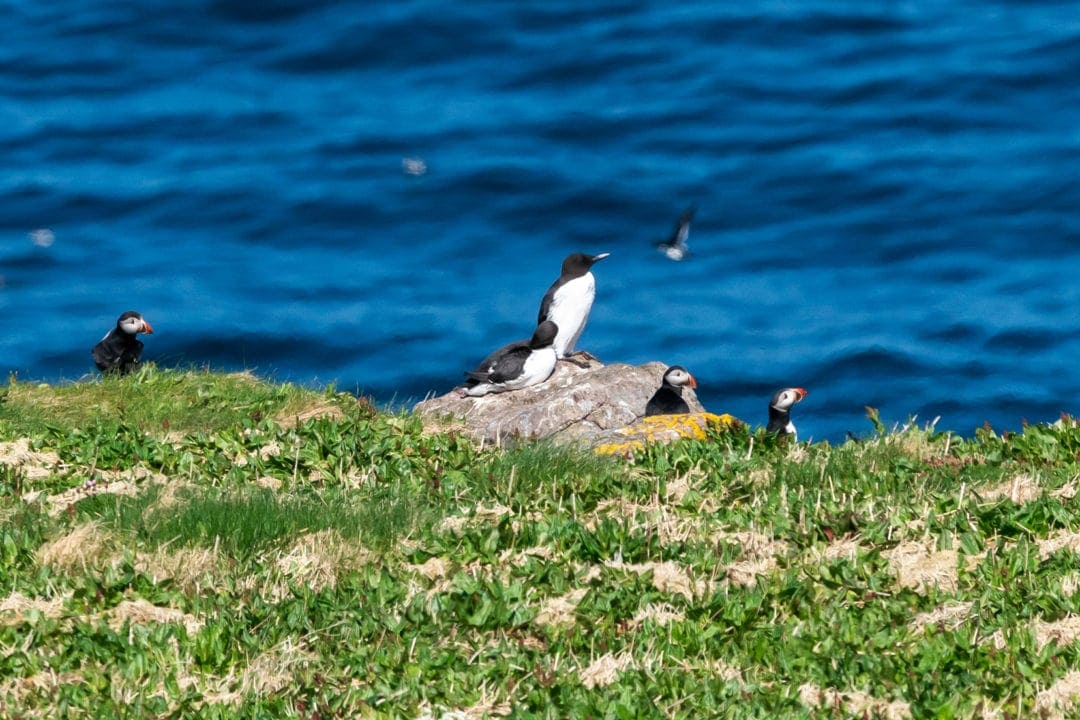
The Torridon sandstone forming the island is 1000 million years old, and Handa Island is part of the North West Highlands Geopark.
Planning a Trip to the U.K.?
- 🚗 Hiring a car? We recommend getting a quote from DiscoverCars
- 🚐 Hiring a campervan? We recommend Motorhome Republic
- ⛑ Arranged your travel insurance? Compare quotes from World Nomads & Safetywing
- 🪪 Order your International Driver’s Licence online here
- 🏩 Booked your accommodation? We use Booking.com to find the best deals
- 🐾 Is someone pet-sitting for you? 🐾 We use and love TrustedHousesitters
- (Get 25% off at checkout for new memberships with our discount code: LIFEJOURNEY25)
Handa Island Video
Our Handa Island Puffin video gives a two-minute snapshot of what it’s like to visit Handa Island.

Handa Island Ferry
The Tarbet to Handa passenger ferry runs from Tarbet Pier to Handa Island from early April to late August.
It normally operates from 9 am to 2 pm, depending on weather conditions for outgoing journeys to the island. However, we recommend arriving early in the morning for the first trip out to Handa to make the most of your day.
The round trip costs £20, payable by cash only when you buy your ticket at the ticket booth beside the Tarbet pier. The Handa Ferry only takes around 12 people at a time, so arrive early ( about half an hour) if it is nice weather because it’s likely to be busy.
The car park, marked on the map, is free but does fill up quickly on a sunny day. It is also the car park for the Shorehouse Seafood Restaurant and Cafe, where you can book a seafood meal or stop by for a cream tea or a quick pint.

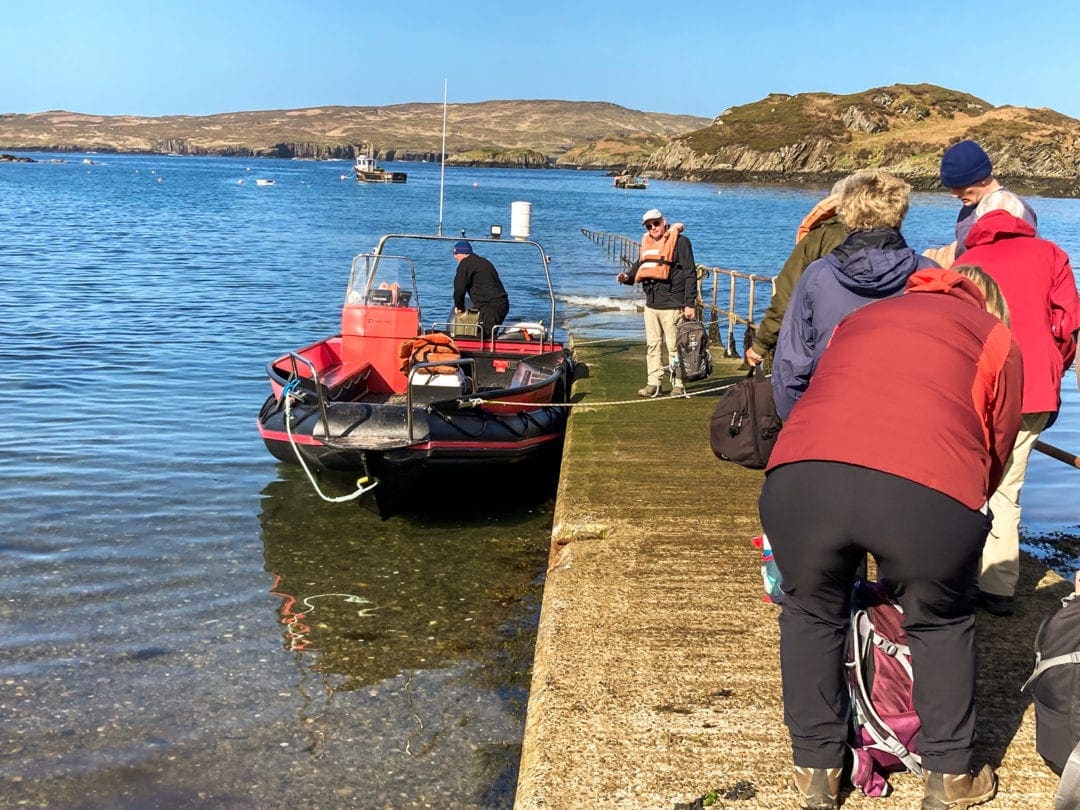
Lifejackets are supplied and must be worn on the short 10-minute boat ride. Make sure you are wrapped up warmly and wearing a waterproof jacket, as the sea spray can whip up on the journey.
Depending on the wind direction, the ferry lands at either of two sandy beaches on Handa Island. There, you’ll be met by a Scottish Wildlife Trust ranger.
The final ferry back to Tarbet departs at around 4.45 p.m. Therefore, make sure you leave plenty of time to arrive at the landing beach for your departure.
No dogs are allowed on the ferry. Makes sense, really, because dogs aren’t allowed on Handa Island due to the protected wildlife.
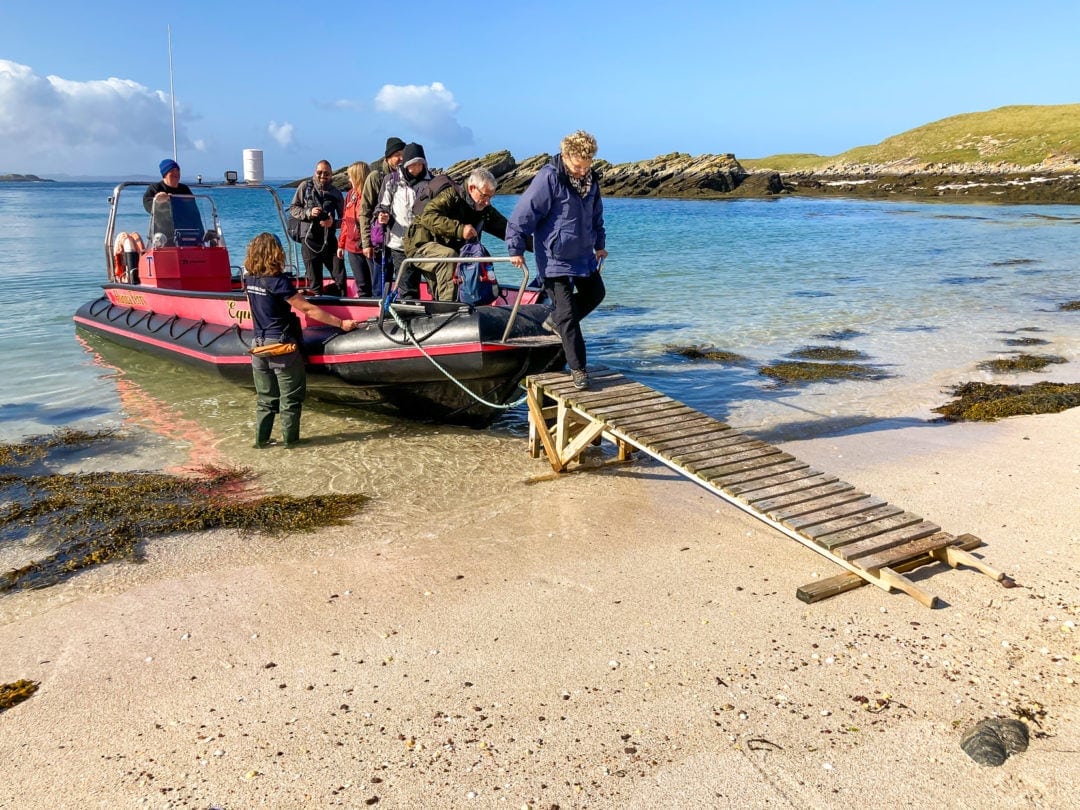
Puffins on Handa Island
We enjoy watching all birdlife, but something about these cute little things has everyone clamouring for a glimpse of them.
Although Handa Island puffin viewing isn’t quite like the Skomer Island puffin experience, they are there, and with a little patience and a keen eye, you’ll likely find more and more as you study the cliffs’ top earthy and grassy areas.
We first spotted them on the Great Stack and then gradually spied more on the nearby cliffs.
They aren’t close, though, so you will need binoculars or a zoom camera. We used a Sony 100-400 mm lens and a Sony 200-600 lens.
We visited in May, and they were still busy collecting clumps of grass for their burrows. From mid-June, you’ll likely see them arrive with mouthfuls of sand eels for their chicks. They then start leaving at the end of July.
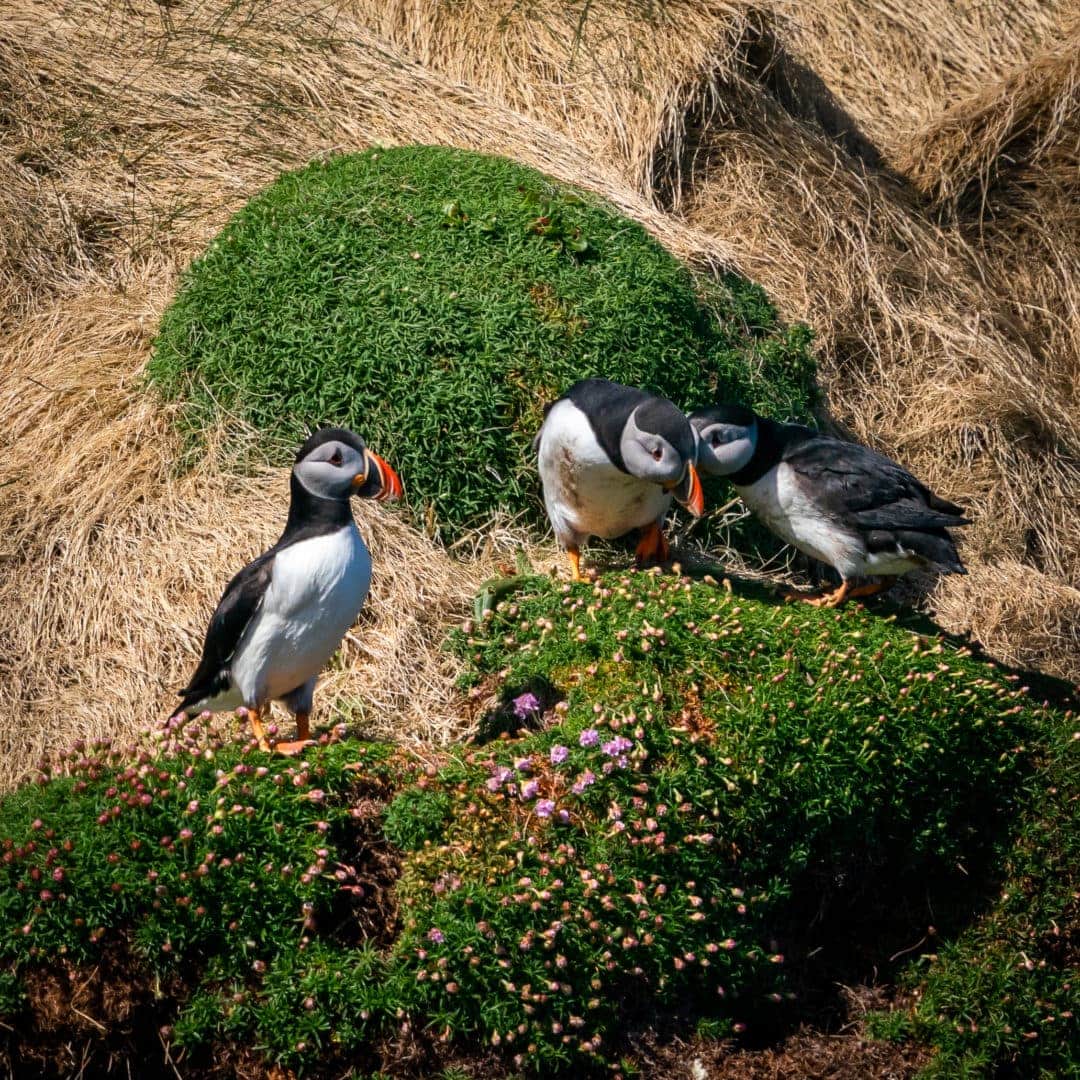
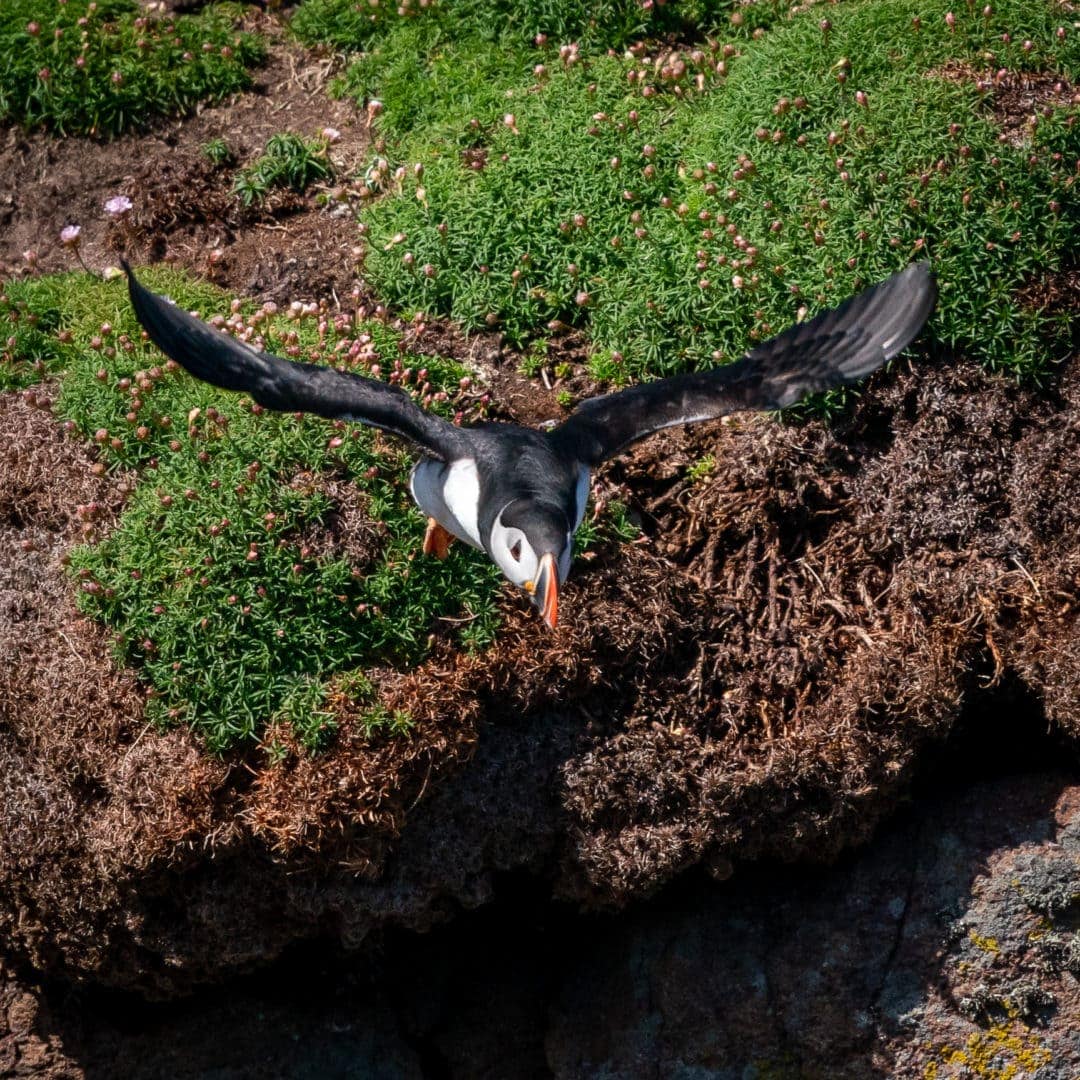
Arriving on Handa Island
You walk to the Information hut once you step off the Handa Ferry. There, the ranger or Wildlife Trust volunteers inform you about the island. They tell you about recent sightings and what to expect along the trail and give you a leaflet with a map of the island.
The rangers will reinforce the island’s rules, such as sticking to the paths and leaving no trace as you enjoy the landscape and wildlife.
There is a composting toilet beside the information hut.

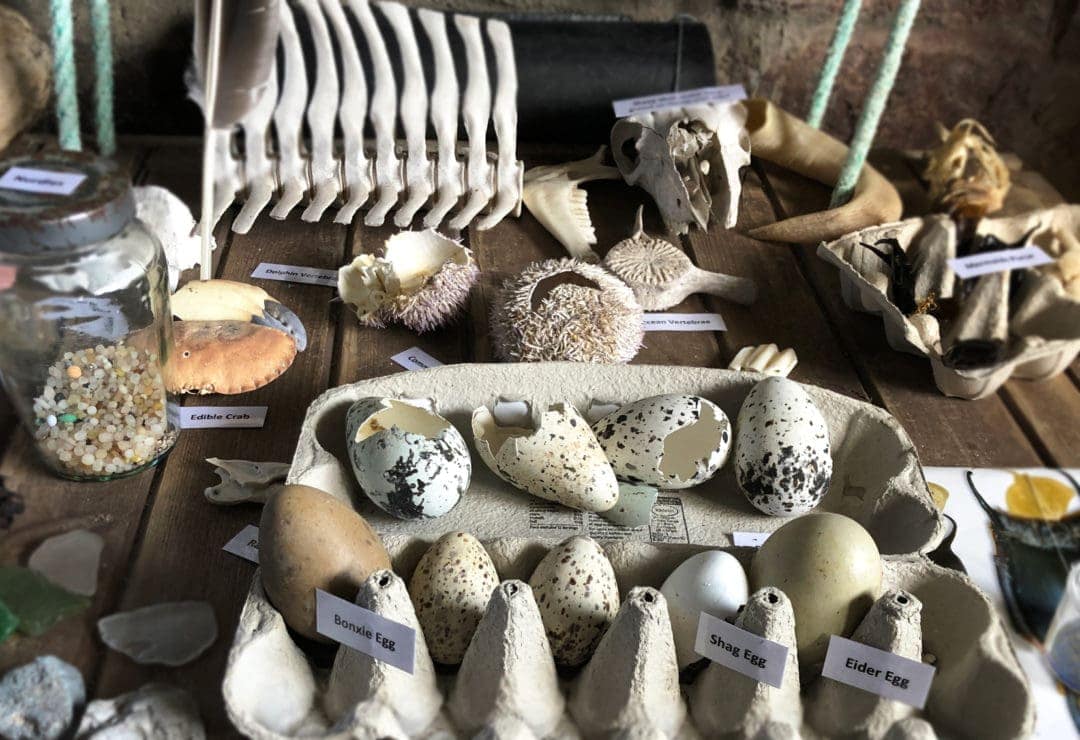
Handa Island Walk
The circular path on Handa Island takes you over moorland, where Skuas rule the roost, along steep sandstone cliffs where tens of thousands of nesting seabirds gather each year, and close to the shore where you might spot any number of marine animals.
The wardens recommend an anti-clockwise route, which first takes you across the Skua-patrolled moorland and the historical ruins of what was once a village on the Island.
The last inhabitants of Handa Island left in 1847, and life was no longer sustainable on Handa. Many emigrated to Nova Scotia in Canada, a popular destination for Scots looking for a better life.
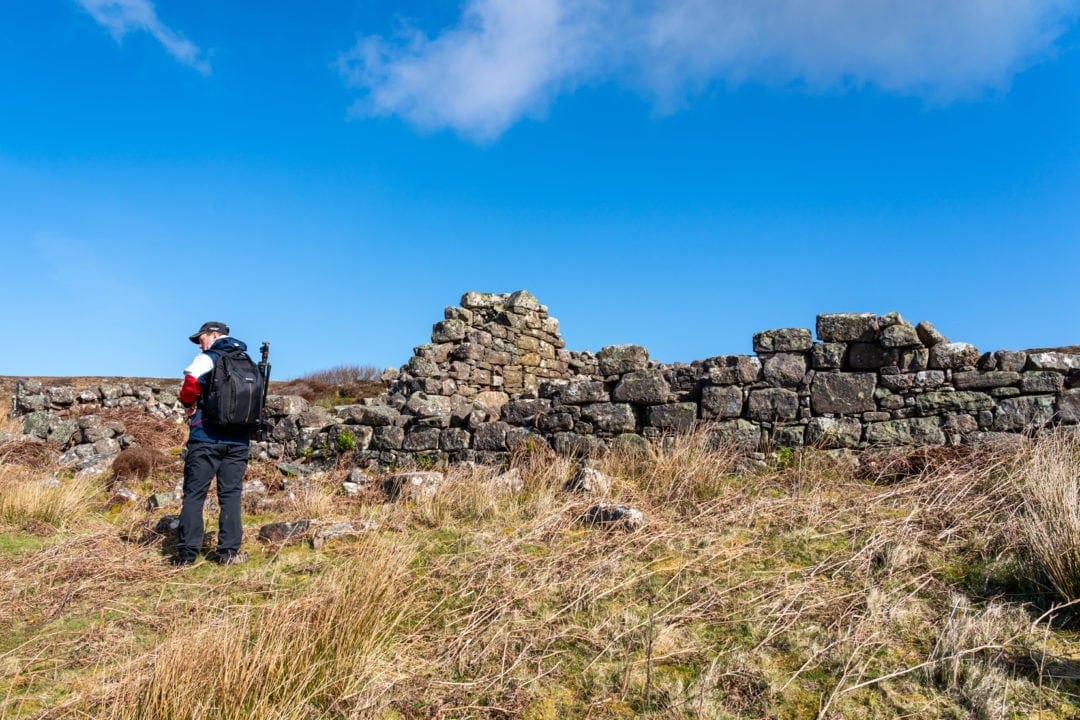
How long does it take to walk around Handa Island?
The island walking trail is 6.4 kilometres long and takes around 2 hours to walk. We were on the island for 6 hours, though, as we took our time taking photos and puffin spotting near the Great Stack.
As you reach the cliffs on the island’s northern side, at Puffin Bay, you will hear and see some of the thousands of seabirds that arrive on Handa for the breeding season. If the wind direction is right, you’ll no doubt smell the birds before you see them, with a waft of rotting fish laying out the red carpet for you.
Although its name, Puffin Bay, suggests you may spot the colourful ‘clowns of the sea‘ here, this isn’t the ideal place to find them. The next promontory, where you’ll find the Great Stack, is where you will most likely see puffins.
Here, every available ledge space seemed to be taken. As we watched, the arguments on who was crossing whose boundary seemed quite intense in some cases, with noisy squabbles and pecking being the order of the day.
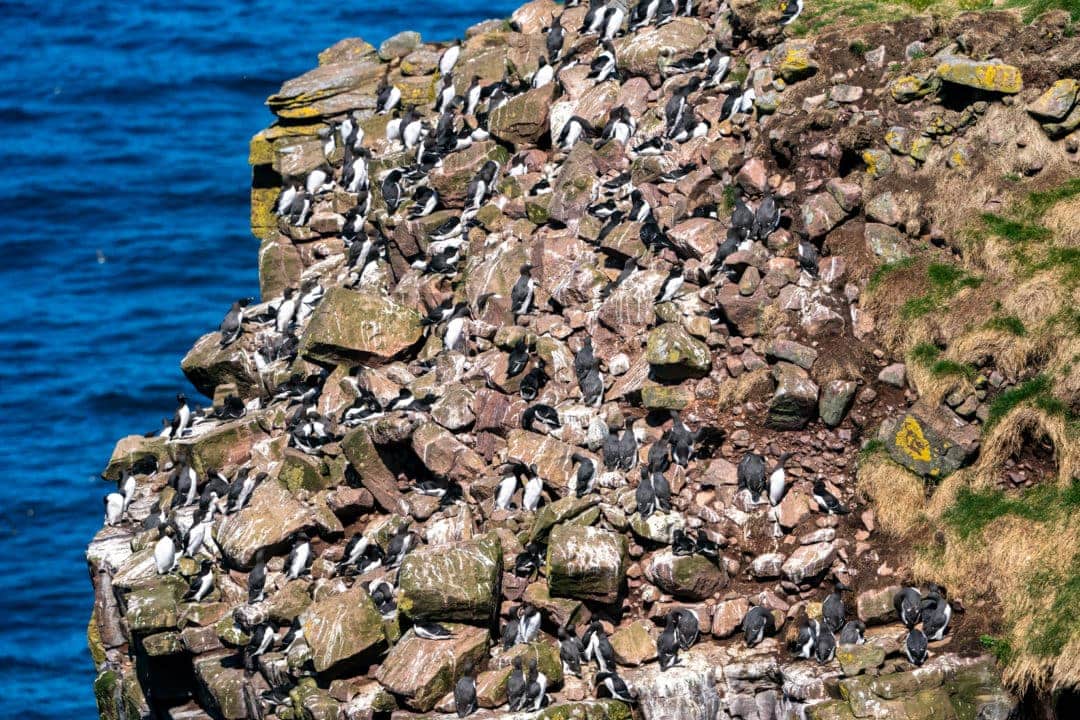
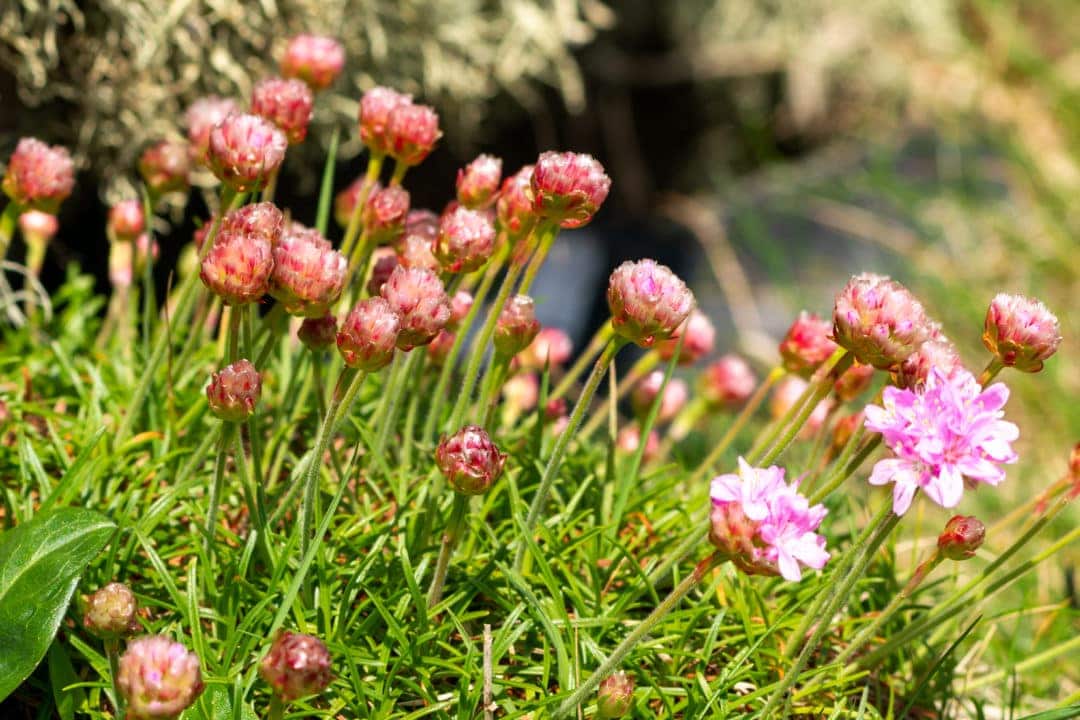
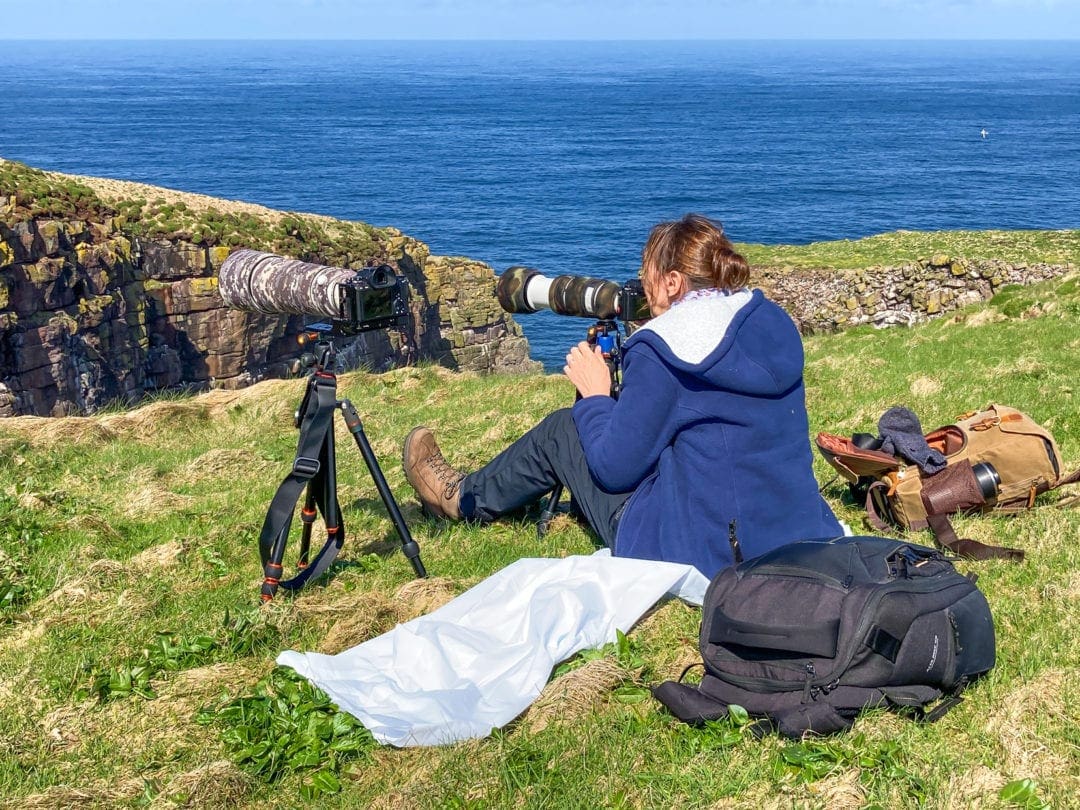
We spent much of our time on the island perched opposite the Great Stack. We wiled the hours away curiously, watching the comings and goings of the birds.
All the while looking out for puffins who were zipping in and out of their burrows and popping up every now and again amongst the grass clumps on top of the stack.

Once we’d had our fill of the birds, we headed back towards the landing beach. The next part of the trail took us along wooden board paths.
Be careful here because the boards change level periodically. You could easily trip if you are admiring the scenery instead of watching your footing.
…Yes, that was me.

Luckily, I didn’t do any damage to myself, but my camera lens hood took a battering … but rather that than my lens itself!
This part of the Handa Island trail takes you down past a collapsed sea cave and closer to the shore at sea level, where interesting block-like rock formations take pride of place.
At Boulder Bay, keep an eye out for otters as they are often spotted in this area, though normally more towards dawn and dusk.
We waited about 10 minutes at the beach for the next boat back to the mainland. In all, we were on the island for about six hours.
Handa Island Wildlife
So, what wildlife might you expect to see on Handa Island?
The Handa Island cliffs teem with seabirds, which include:
- Guillemots
- Razorbills
- Kittiwakes
- Puffins
- Fulmars
- Shags (Cormorants)
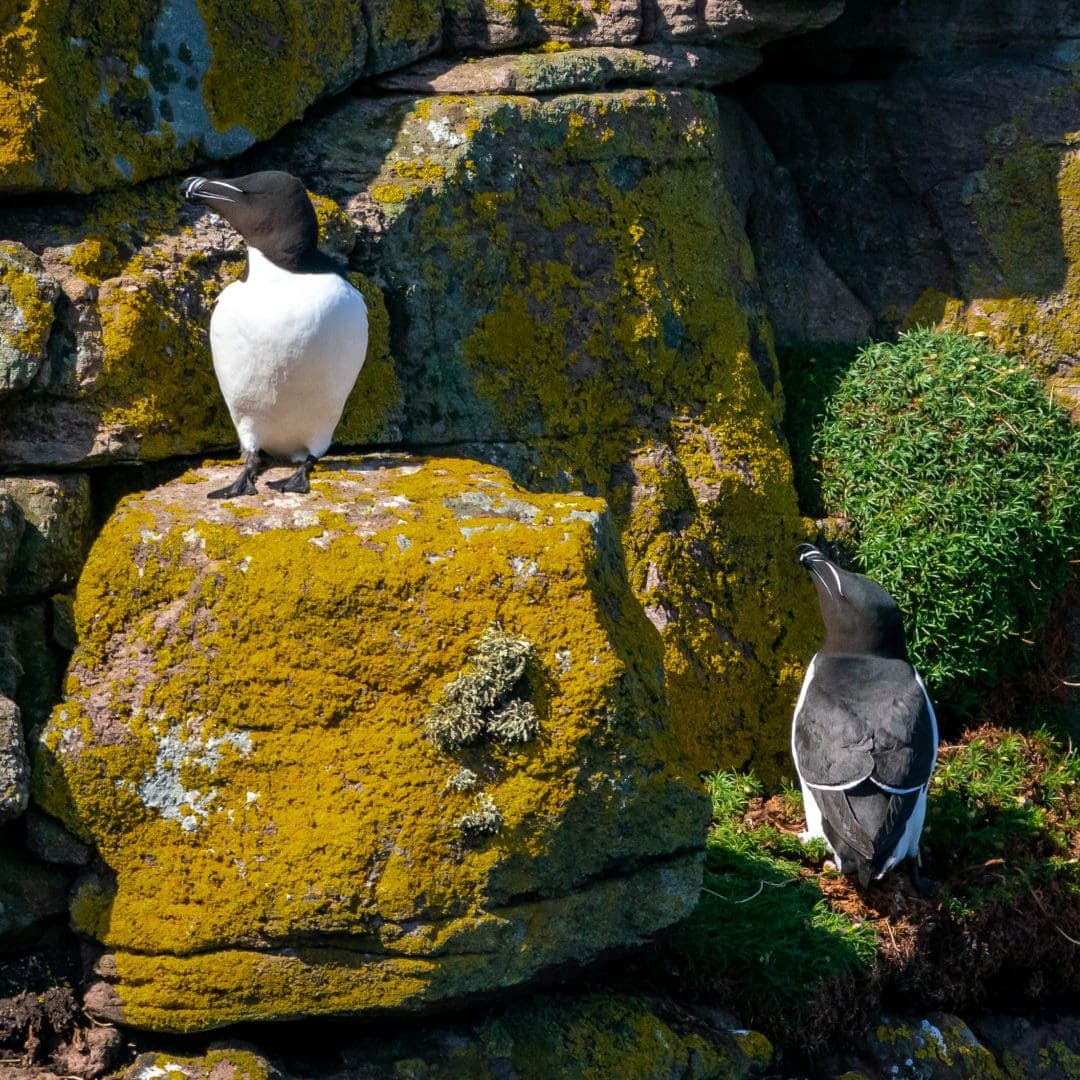
You’ll also see plenty of great skuas (known as Bonxies in Scotland) flying around and nesting in the moorland heath. They are known to be very defensive of their territory — especially when they have eggs and chicks. Wave your arms around above you if they decide to attack, or even better, a walking pole if you have one.
Around the shore, you might also spot oystercatchers and eider ducks.
Handa Island hosts one of Britain’s largest guillemot colonies (called loomeries ). The guillemots, sometimes packed with 70 birds per square metre, don’t make nests but lay a special conical-shaped egg to prevent it from rolling off the ledge.
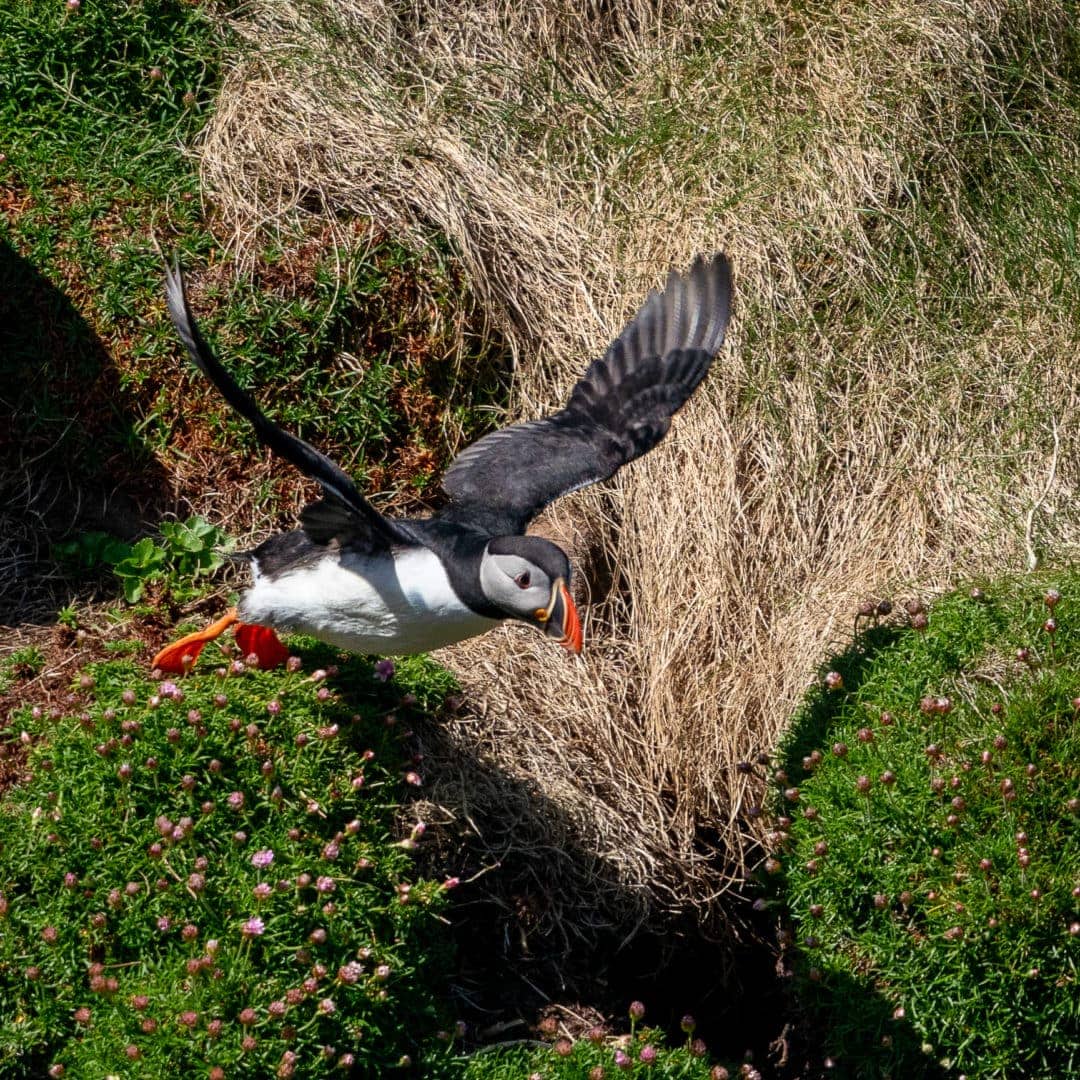
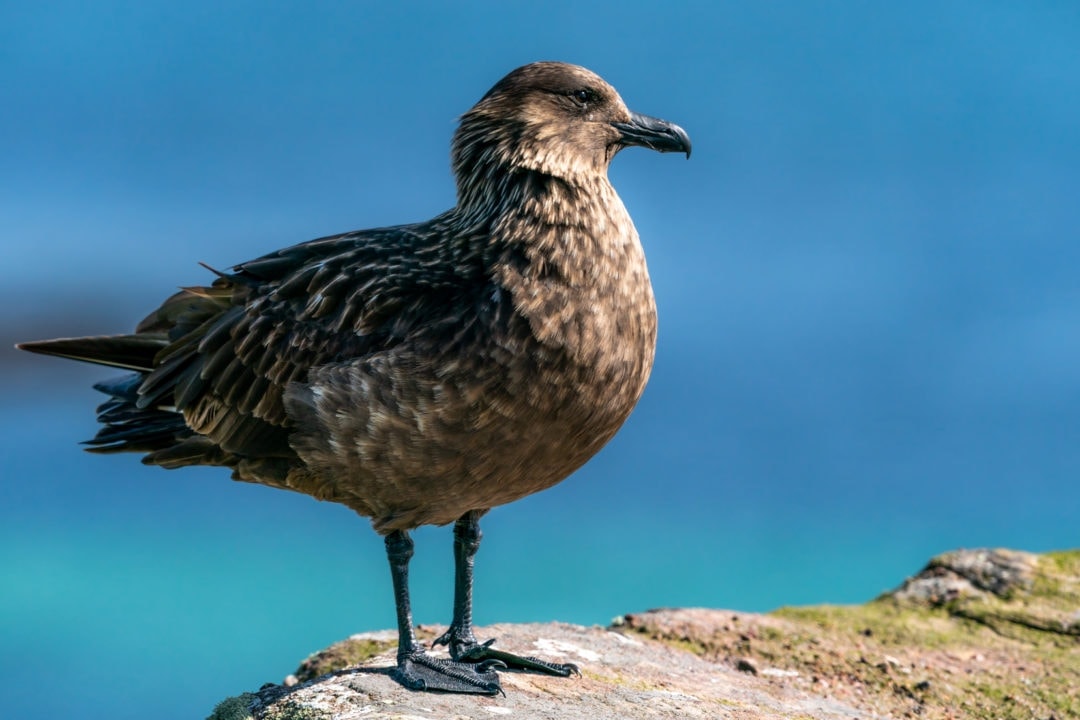
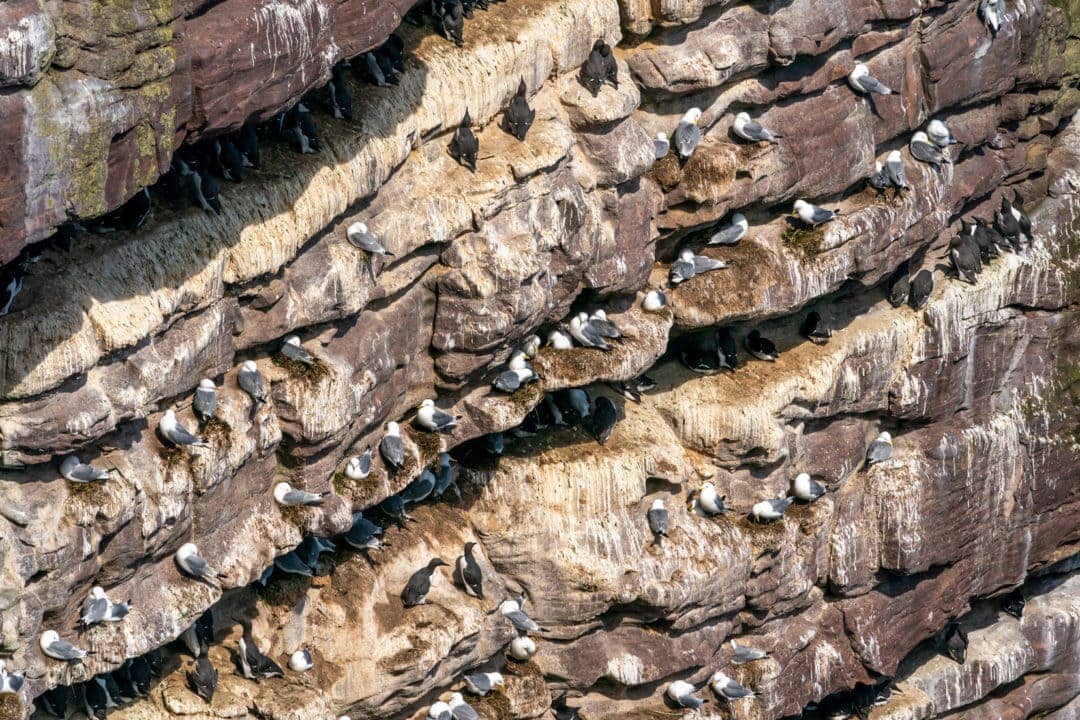
From the excellent vantage point of the cliffs, which are more than 100 metres high in some places, you might spot whales, dolphins, porpoises, seals, basking sharks, minke whales or orcas.
Down by the shore, watch out for otters and seals cruising the coastline.
You may also spot small black devices dotted around the island. These are in place to deal with the rat problem. You might wonder how rats are on the island in the first place.
Surprisingly, they swim in open water from the mainland. The rats threaten the ground-nesting birds on the island by destroying their nests and feeding on their eggs and chicks.
Clothing for Handa Island
The weather in Scotland can change in a moment, so to ensure your Handa Island trip is enjoyable, I suggest dressing for all weathers. Layers are the way to go, so you can strip off or layer up depending on the temperature.
The trip across to the island can also see you getting splashed by waves so waterproofs are handy to wear on the boat trip. You will also need waterproofs for the island so you won’t get drenched in an unexpected downpour. This can happen even if you set off with clear blue skies and the weather forecast says ‘no rain’.
Trust us, we know;)
Also, make sure to wear sturdy walking boots or shoes as although you follow paths on the island you have about a three to four-hour walk around the island.
Remember to pack water to drink and snacks and lunch as there aren’t any facilities on the island.
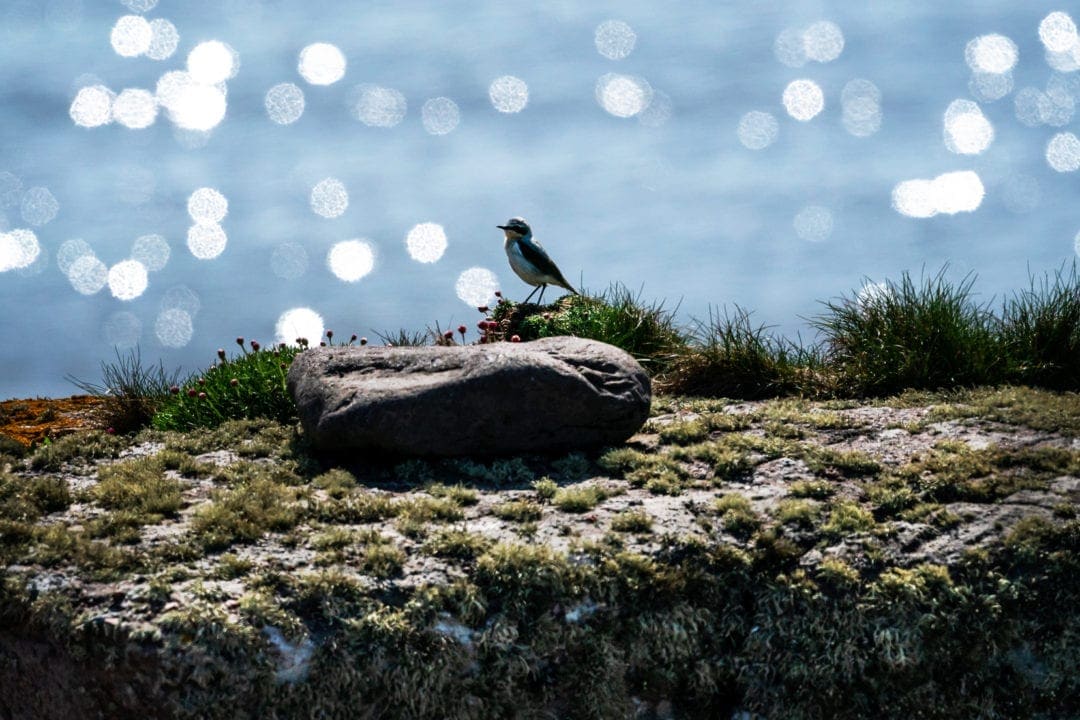
Where to Stay Near Handa Island
We stayed at the Old School Room BnB, locally owned and run, with a great restaurant. It was absolutely fabulous and great value for money with a superb full Scottish breakfast included in the price.
Just 13 miles and a 23-minute drive to Handa Ferry.
Address: Inshegra, Kinlochbervie, Sutherland IV27 4RJ
Handa Island… That’s a Wrap
For bird lovers, nature lovers and photographers alike, a trip to Handa Island is the perfect place to immerse yourself in a serene and pristine environment.
A time to be in the moment and to appreciate this Scottish wilderness and the all-important seasonal affair of nesting on Handa Island.
Pin and Save for Later
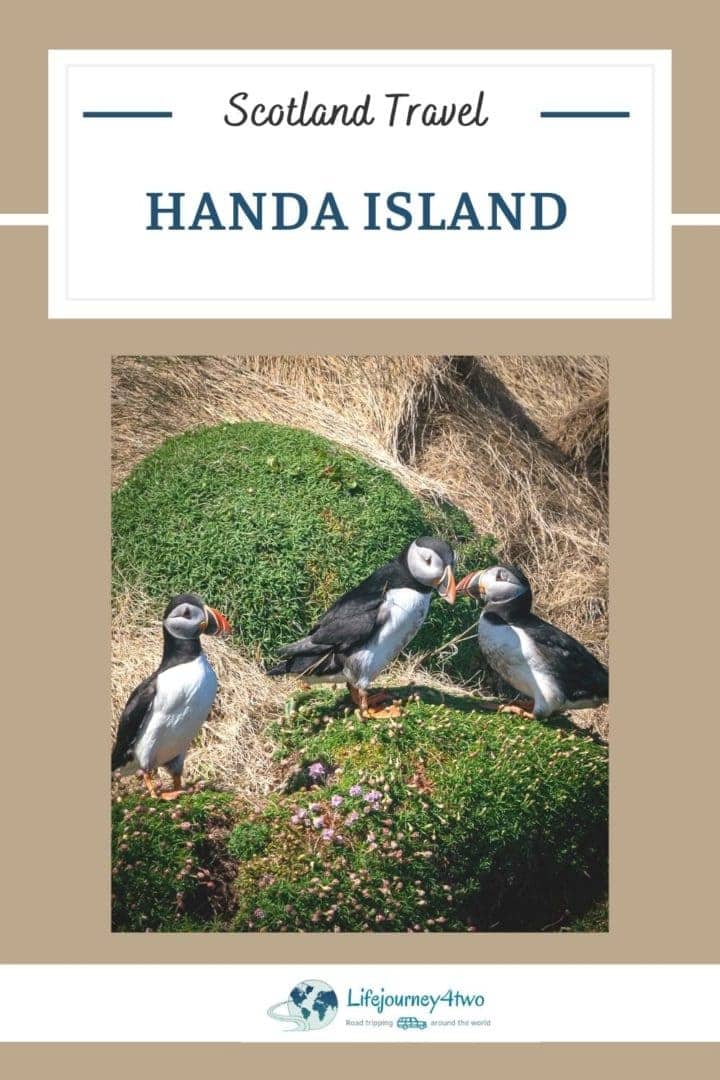
Read More:
- Scotland Destination Travel Guide
- Wildlife Encounters Around the World
- Gannets Galore at Troup Head, Scotland
- Skomer Island Puffins, Wales
- Outer Hebrides Road Trip
Planning Your Travels?
These are the travel resources we recommend and use when planning our trips.
- 🚘 Car Hire: We use DiscoverCars.com
- Motorhome/Campervan Rental: We highly recommend the Motorhome Republic
- 🪪 Order your International Driver’s Licence online here
- 🛏 Book Accommodation: We use Booking.com to find accommodation that suits our budget
- 🐶 Pet Sitting/Pet Sitters: Check Out TrustedHousesitters here (Use our Discount code: LIFEJOURNEY25 for 25% off. )
- Activities and Experiences: Get Your Guide and Viator
- Travel Insurance: Safetywing or World Nomads
- 🥾 Travel Gear and Accessories: Check out our top picks here — Lifejourney4two page on Amazon
For a more thorough list, visit our Travel Resources page here.

